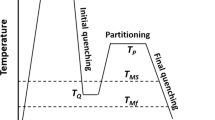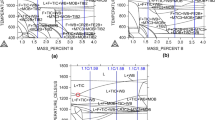Conclusions
-
1.
an increase in the plasticity and resilience of chromium type 10Kh9MFB steel after heat treatment is associated primarily with variation in the form of segregation and the character of the distribution of the carbide phase M23C6.
-
2.
After air quenching from 1050°C (i.e., above Ac3), carbides with an acute-angle, platelike shape, which are distributed preferentially along the grain boundaries and bainitic laths, are segregated in steel 10Kh9MFB during tempering in the 600–700°C interval. These carbides are unstable during tempering, and effect an increase in the percent of brittle intergranular failure; this leads to a reduction in the steel's plasticity and resilience.
-
3.
Spheroidized carbides M23C6 of equiaxial shape, which are uniformly distributed along the grain boundaries and body, are segregated when chromium type 10Kh9MFB steel is heated in the intercritical region. These carbides are in equilibrium with the matrix and retain their own stability over a broad range of tempering temperatures from 600 to 760°C, ensuring high plasticity and resilience when the steel's failure is ductile in nature.
Similar content being viewed by others
Literature cited
S. A. Golovanenko and N. M. Fonshtein, "Dual-phase ferritic-martensitic steels," Metalloved. Term. Obrab. Met., No. 11, 25–29 (1984).
S. A. Golovanenko and N. M. Fonshtein, "Structural dual-phase steels," Results of Science and Engineering. Metal Science and Heat Treatment [in Russian], Vol. 17, Vsesoyuznyi Institut Nauchnoi i Tekhnicheskoi Informatsii, Moscow (1983), pp. 64–120.
S. S. Golubev, V. I. Ul'yanin, and V. M. Adeev, "The fine structure of low-carbon steel after normalizing from temperatures of the intercritical region Ac1-Ac3," Metallofizika, No. 62, 78–83 (1975).
A. I. Kogan, É. F. Matrokhina, and R. I. Éntin, "Effect of austenitizing in the intercritical temperature interval on the structure and properties of low-carbon steels," Fiz. Met. Metalloved.,52, No. 6, 1232–1241 (1981).
B. B. Vinokur, "Carbide transformations in structural steels," Metalloved. Term. Obrab. Met. No. 8, 35–39 (1985).
S. V. Grachev, V. A. Korablev, and A. I. Shkolenko, "Effect of quenching temperature on processes that occur during the tempering of hardened steel," Fiz. Met. Metalloved.,56, No. 6, 1220–1222 (1983).
N. N. Lanchin, "Effect of phase-II on the structural mechanism of austenite-grain formation," Izv. Vyssh. Uchebn. Zaved., No. 3, 146–151 (1965).
Additional information
Nongovernmental Organization Central Scientific-Research Institute of Technology and Machine Building. Translated from Metallovedenie i Termicheskaya Obrabotka Metallov, No. 12, pp. 48–50, December, 1987
Rights and permissions
About this article
Cite this article
Shchenkova, I.A., Karpova, N.A. & Stepanova, I.A. Effect of treatment from the intercritical interval on the state of the carbide phase in chromium steel. Met Sci Heat Treat 29, 950–953 (1987). https://doi.org/10.1007/BF00707595
Issue Date:
DOI: https://doi.org/10.1007/BF00707595




